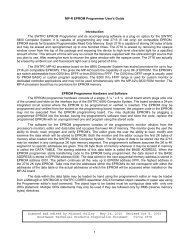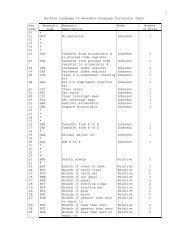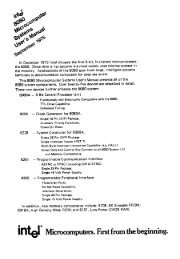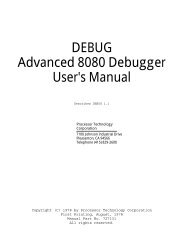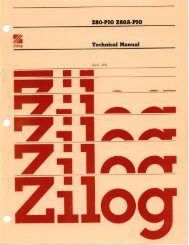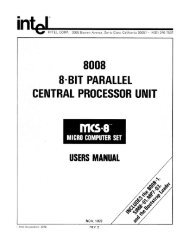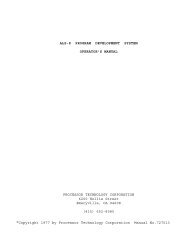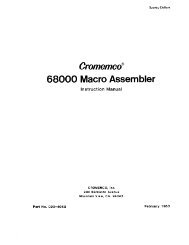The System Manual of SOL-20 - History of Computers
The System Manual of SOL-20 - History of Computers
The System Manual of SOL-20 - History of Computers
You also want an ePaper? Increase the reach of your titles
YUMPU automatically turns print PDFs into web optimized ePapers that Google loves.
PROCESSOR TECHNOLOGY CORPORATION<br />
Sol THEORY OF OPERATION<br />
SECTION VIII<br />
As indicated in Figure 8-4 on Page VIII-27, Subgroup Counter<br />
U31 and Group Counter U33 are preset to a count <strong>of</strong> 3 at the start <strong>of</strong><br />
each horizontal scan line. U31 counts from 3 through 15 (13 character<br />
positions) and enables U33 for one count. U31 then counts 0<br />
through 15 and enables U33 for the second count. <strong>The</strong> sequence continues<br />
through four more groups <strong>of</strong> 16 character positions, and at<br />
this point U33 is at its sixth count (a binary 9). Thus, pins 11 and<br />
14 are high at pins 10 and 11 <strong>of</strong> U47. U31 continues to count from 0,<br />
and on the ninth count (a binary 8) pin 9 <strong>of</strong> U47 goes high. <strong>The</strong> resulting<br />
low on output pin 8 <strong>of</strong> U47 loads three into U31 and U33, and<br />
the cycle repeats. <strong>The</strong> U31-U33 cycle) from preset, is then 13, 16,<br />
16, 16, 16, 16 and 9 character position counts for a total <strong>of</strong> 102.<br />
<strong>The</strong> QD output on pin 11 <strong>of</strong> U33 is SCAN_ADV, and the QC output<br />
on pin 12 is HDISP. SCAN_ADV is used to generate horizontal synchronization<br />
signals, and HDISP defines the start <strong>of</strong> the display portion<br />
<strong>of</strong> the horizontal scan line.<br />
Four outputs from U31 and the two low order outputs <strong>of</strong> U33<br />
(pins 13 and 14) are input to the Character Address Multiplexer, U30<br />
and U32, which supplies the low order six address bits to the Display<br />
RAM (U14 through U21). <strong>The</strong> second address source for the Display RAM<br />
is the Address Bus, bits ADR0-5. Address source selection is controlled<br />
by the output on pin 7 <strong>of</strong> D flip-flop U75. Pin 7 <strong>of</strong> U75 goes<br />
high when !PAGE_CC (the Display RAM) is active and !(PSYNC & !φ2) goes<br />
high (which it does in the middle <strong>of</strong> PSYNC). Pin 7 <strong>of</strong> U75 remains<br />
high for the rest <strong>of</strong> the memory access cycle.<br />
<strong>The</strong> preset signal (pin 8 <strong>of</strong> U47) to U31 and U33 is applied to<br />
the Scan Counter (U4O) via inverter U87. U40 counts the horizontal<br />
scan lines that make up a row <strong>of</strong> characters and supplies the line<br />
number to U25, the Character Generator ROM. (This ROM is discussed<br />
later.) U40 is preset to a count <strong>of</strong> 15 for the first scan line in<br />
the character row. It then counts from 0 through 11. On count 11,<br />
SCAN_ENABLE on pin 8 <strong>of</strong> U47 is inverted in U87 to disable the Scan<br />
Counter. A decoder, comprised <strong>of</strong> NAND gates U59 and U60, decodes the<br />
13th count (count 11) in U40 and SCAN_ENABLE to supply a load pulse<br />
to pin 9 <strong>of</strong> U40. This resets U40 to a count <strong>of</strong> 15, and the cycle repeats.<br />
(Presetting the Scan Counter to a count <strong>of</strong> 15 permits the<br />
Character Generator ROM to provide a blank spacer line between character<br />
rows since line 15 in the ROM is always blank.)<br />
<strong>The</strong> output on pin 8 <strong>of</strong> NAND gate U59, after inversion in U87,<br />
becomes the OVERFLOW_LINE signal. This signal occurs after each<br />
character row and appears at pins 7 and 10 <strong>of</strong> Text Counter U62 to<br />
enable it to count. Thus, the Text Counter counts character rows.<br />
It resets itself with its carry output (pin 15) through another inverter<br />
in U87, with the reset count being determined by the state on<br />
pin 10 (VDISP) <strong>of</strong> J-!K flip-flop U43. If VDISP is low, the Text<br />
Counter resets to a count <strong>of</strong> 0; if VDISP is high, it resets to a<br />
count <strong>of</strong> 12.<br />
VIII-25



